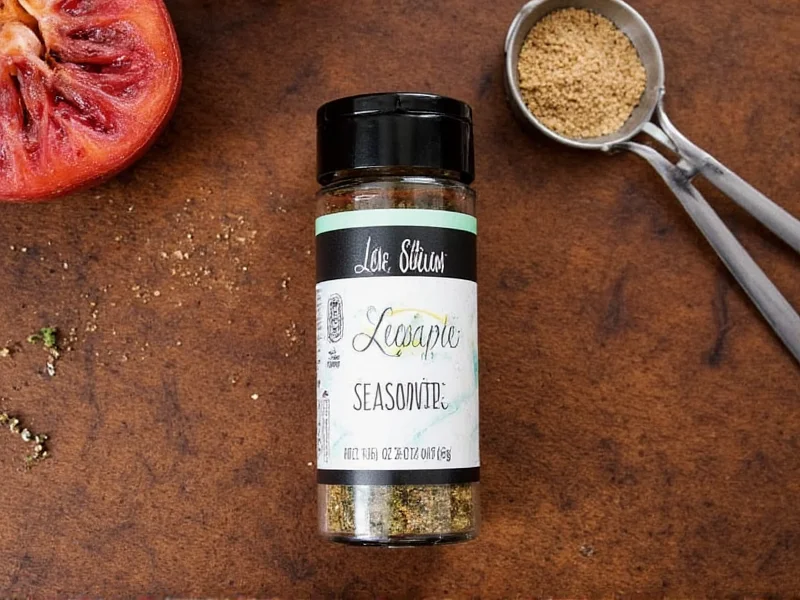Why Reducing Sodium in Seasonings Matters for Your Health
Excessive sodium intake contributes to hypertension, heart disease, and stroke. The average American consumes about 3,400 mg of sodium daily—more than double the American Heart Association's recommended limit of 1,500 mg. Seasonings and flavor enhancers often hide significant sodium content that accumulates throughout the day. Switching to less sodium seasoning options provides an immediate reduction in daily sodium intake without compromising taste satisfaction.
Research shows that gradually reducing sodium while enhancing other flavor dimensions allows your taste buds to adapt within 6-8 weeks. This transition period makes lower-sodium options increasingly satisfying as your palate adjusts. The key is understanding which alternatives work best for different cooking applications and flavor profiles.
Effective Categories of Low-Sodium Seasoning Alternatives
Not all low-sodium seasonings work equally well across different dishes. Understanding these categories helps you make strategic substitutions:
| Seasoning Category | Sodium Content (per tsp) | Best Used For | Flavor Profile |
|---|---|---|---|
| Single-Ingredient Spices | 0-5mg | All cooking applications | Pure, distinct flavors (cumin, paprika, etc.) |
| Herb Blends (no salt) | 0-20mg | Vegetables, poultry, fish | Earthy, aromatic, fresh |
| Potassium-Based Substitutes | 0-100mg | General salt replacement | Salty taste with metallic aftertaste |
| Acid-Based Enhancers | 0mg | Salads, vegetables, finishing dishes | Bright, tangy, refreshing |
| Umami-Rich Options | 5-30mg | Meats, soups, sauces | Savory, deep, satisfying |
Maximizing Flavor with Low-Sodium Seasoning Techniques
Simply replacing high-sodium seasonings with low-sodium alternatives often yields disappointing results. Professional chefs use specific techniques to build flavor complexity without relying on salt:
Layering Flavors Strategically
Apply seasonings at different cooking stages: add dried herbs early in cooking, fresh herbs near the end, and acid-based enhancers after cooking. This creates dimension rather than a single-note flavor. For example, when roasting vegetables, toss them with olive oil, garlic powder, and dried thyme before cooking, then finish with lemon zest and fresh parsley.
Understanding Flavor Synergies
Certain combinations naturally enhance perception of saltiness without adding sodium. The combination of garlic and black pepper creates a perception of increased saltiness. Similarly, adding a small amount of acid (like citrus juice) can make foods taste more seasoned. Umami-rich ingredients like mushrooms, nutritional yeast, or tomato paste provide depth that compensates for reduced sodium.
Creating Your Own Low-Sodium Seasoning Blends
Homemade blends give you complete control over ingredients and allow customization for personal taste preferences. These foundational recipes provide starting points that you can adjust to your liking:
Basic All-Purpose Blend
Mix 2 tablespoons each of garlic powder, onion powder, dried thyme, and dried basil with 1 tablespoon each of black pepper and paprika. Store in an airtight container for up to 6 months. This versatile blend works well on chicken, fish, vegetables, and in soups.
Citrus-Herb Seasoning
Combine the zest of two lemons or limes with 2 tablespoons each of dried dill, parsley, and chives plus 1 tablespoon of coriander. The citrus zest provides immediate flavor impact while the dried herbs offer depth. Use on seafood, salads, and roasted vegetables.
Reading Labels: Identifying Hidden Sodium in Seasonings
Many products marketed as healthy contain surprising amounts of sodium. When evaluating store-bought options, watch for these common sodium-containing additives:
- Sodium benzoate (preservative)
- Monosodium glutamate (MSG)
- Sodium caseinate
- Sodium erythorbate
- Sodium nitrate/nitrite
- Disodium inosinate
Marketing terms like "reduced sodium" only mean the product contains 25% less sodium than the original version—not that it's low in sodium. Look for products specifically labeled "no salt added" or "sodium-free" for the lowest sodium content. Always check the nutrition facts panel for milligrams of sodium per serving and consider how many servings you'll actually use in a dish.
Transitioning to Low-Sodium Seasoning Successfully
Abandoning high-sodium seasonings cold turkey often leads to disappointment. Instead, implement these practical strategies for a sustainable transition:
Begin by mixing your regular seasoning with a low-sodium alternative in a 3:1 ratio. Gradually increase the proportion of low-sodium seasoning over 4-6 weeks. This gradual approach allows your taste buds to adjust without feeling deprived. Simultaneously, enhance other flavor dimensions by incorporating more fresh herbs, citrus, and umami-rich ingredients to compensate for reduced saltiness.
Track your progress by noting how your taste preferences change over time. Many people report that after 6-8 weeks of reduced sodium intake, previously enjoyed high-sodium foods taste excessively salty. This adaptation is a positive sign that your palate is becoming more sensitive to natural food flavors.











 浙公网安备
33010002000092号
浙公网安备
33010002000092号 浙B2-20120091-4
浙B2-20120091-4